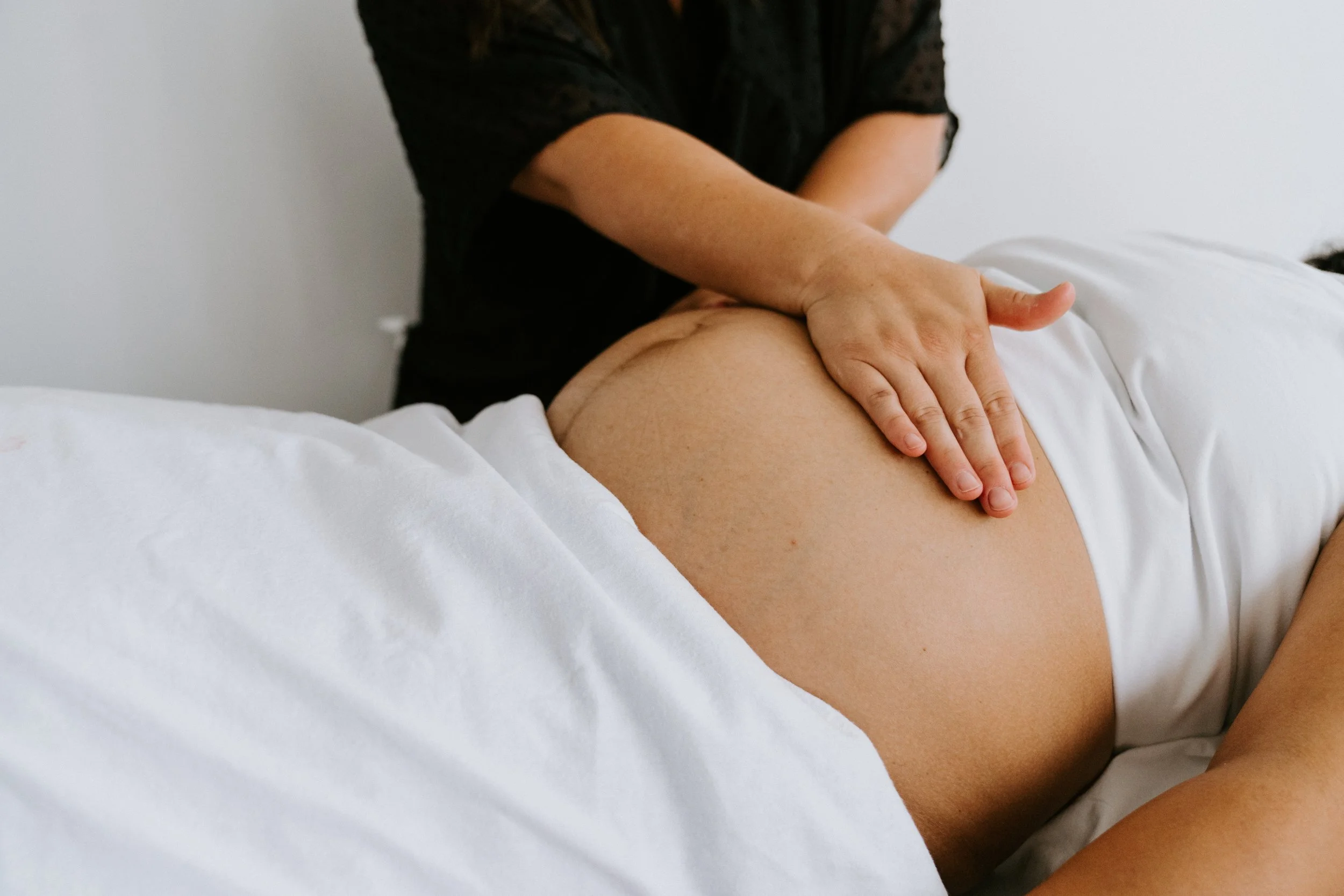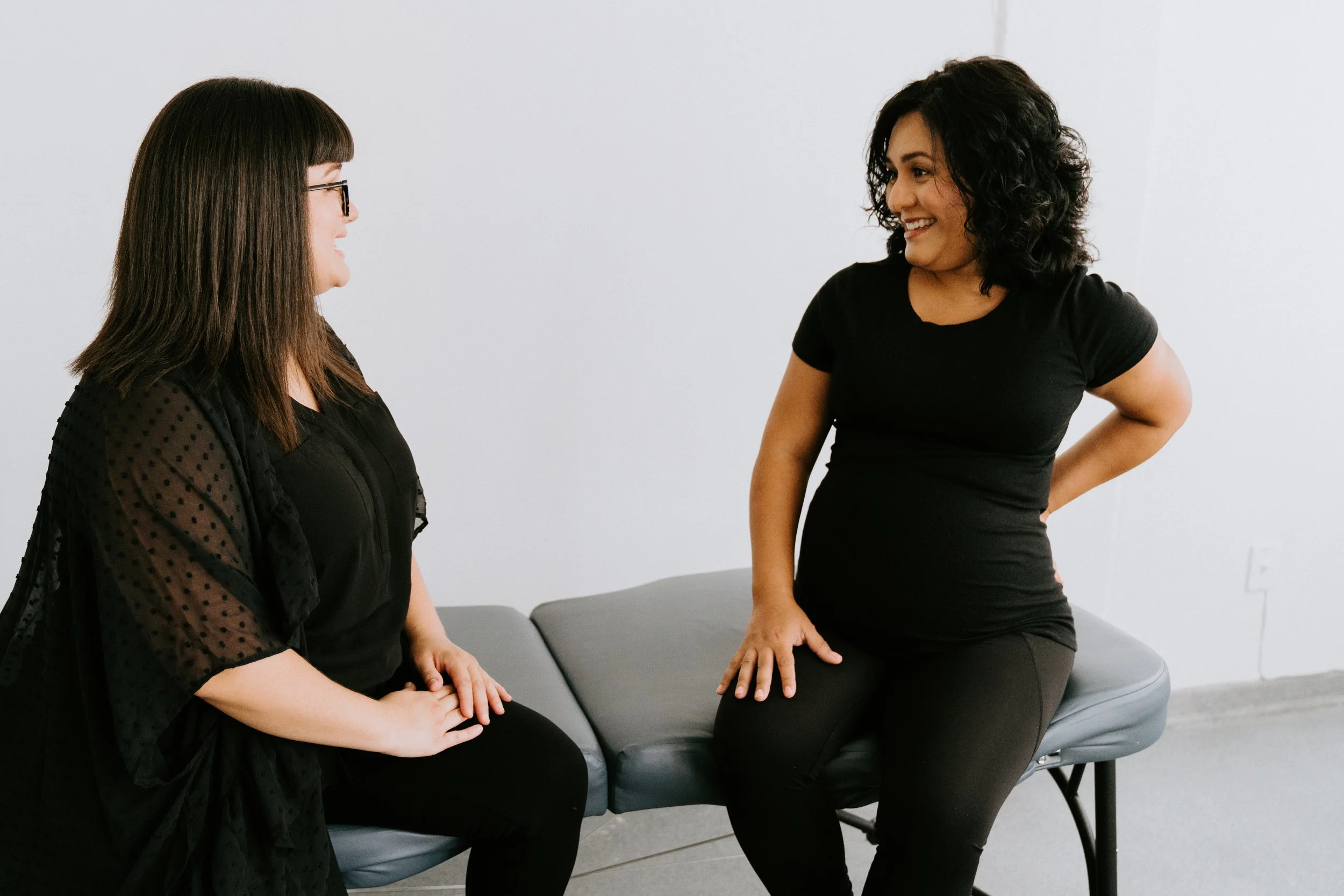Prenatal massage.
Curious about prenatal massage? Then (soon-to-be) mama, you are in the right place! Please use this page as a resource to answer any questions you may have about prenatal massage. If you can’t find what you are looking for send us an email and we will try and answer your question.
The benefits.
There are many reasons and benefits to receiving massage while pregnant. Not only does massage feel good, but there are a variety of studies that suggest massage can help reduce prenatal and postpartum depression, prematurity and low birth weight, improve sleep patterns, lower cortisol or stress levels, alleviate pain in pregnancy and in labor. Here are a few more benefits to receiving massage in pregnancy:
Minimizes discomforts of pregnancy’s hormonal, respiratory, gastrointestinal, and other physiological adaptations
Develops the flexibility and kinesthetic awareness necessary to actively participate in the birth process
Fosters nurturing maternal touch and healthy bonding
Reduces stress, promotes relaxation and facilitates transitions through emotional support and physical nurturing.
Reduces the negative effects of the circulatory system changes, including edema, varicose veins and increased blood pressure
Reduces musculoskeletal strain and pain
A knowledgable prenatal massage therapist can help you to prevent, reduce and manage the pain that you might experience in your pregnancy. We support and encourage the transitions that your body makes during this crucial time. In addition to the hands on techniques, education can also help reduce pain and decrease the stress your body goes through. We can help educate you in safe body-use guidelines for walking, sitting, sleeping, carrying and other daily activities that reduce further strain on your neck, back and pelvis.
Is prenatal massage safe?
The short answer is: it depends. Nearly every pregnant person can safely benefit from some type of therapeutic bodywork. But thats not to say certain factors don’t play a role. Which week or trimester you are in, how we position and support you in session, which areas need to be worked on, massage pressure, intensity and speed, baby and moms health can all factor into the safety and how you may receive massage. This is why we ask you to complete our detailed client intake form, and provide a pre-consultation at the start of your session. Our licensed massage therapists will help guide and work with you to determine the safest and most effective way to help your body feel better.
What can I expect from my prenatal massage?
If you’ve never had a prenatal massage before, or are simply new to massage, the experience can be understandably daunting at first. How does this work? What do I do? Where does my growing belly go?
All excellent questions, and ones that will be answered at the start of your session. In our massage practice, your massage therapist will go over your intake form to find out any pertinent details that can help them decide what their treatment may look like.
We also like to set aside time for a brief 5-10 minute chat, our pre-consultation, to discuss with you what goals you might have for your massage, how your pregnancy is going, what daily activities you engage in, how your sleep is, etc. All of this information is so important to us, as it gives us an excellent starting off point in how we will approach the massage, and what possible education we can provide for you, for in-between sessions.
If it is your first prenatal massage with us, we will take you over to our massage table and describe how we will position you. In our practice your therapist will position you in a variety of different ways depending on what will be safest and most effective for your body. If you are relatively early on in your pregnancy, and are still comfortable laying face down without any supports, not much will change from a regular massage position, but once your belly starts to grow we can provide other options for comfort.
First we can position you in a supported prone, or face down position. We do this by using a body cushion pregnancy system which allows a pregnant person to comfortably lay face down, while supporting the chest, growing belly, pelvis and ankles. We can also place you in a comfortable side lying position using pillows or our side lying positioning system, supporting the head and neck, alleviating pressure on the shoulder, supporting the belly, hips and legs. Lastly, you can be placed in a supine, or face up position, in which we use additional pillows or our giant wedge pillow to prop you up. Whatever position is used, we can guarantee you will feel extremely comfortable and supported, and if any adjustments need to be made, we encourage that feedback.
After explaining how to get onto the table the therapist will leave the room to wash their hands, while you disrobe and get onto the table. During the session, the therapist will communicate with you on pressure, asking if you prefer more or less. Depending on the needs of the client, the therapist may also find opportunities to educate you on their findings and how to help alleviate certain concerns.
At the end of the session the therapist will excuse themselves to wash their hands while you get off the table and dressed. We’ll end with our post-consultation. Here is where you can discuss any questions you may have about what happened during session, we can discuss what we found and provide breath work, stretching, self massage techniques or other education to help you feel better in your body. We may also recommend other trusted professionals, depending on what additional birth team support you may need in your pregnancy.
When & how often should I receive prenatal massage?
This is a common question and depends on what your goals, schedule and budget are for the duration of your pregnancy. Every pregnancy and every person is different, which is why speaking with your therapist for specific guidelines can be helpful. You can start receiving massage at any point in your pregnancy. Generally we recommend 1-2 times per month until about 36 weeks. After that we recommend at least once a week until delivery. This will help to ensure that you are both physically and emotionally feeling your best once its time to deliver.
If regular massage is something that you plan to add to your prenatal care team, we recommend taking a look at our Nurtured Mama massage packages, which will help you commit to your wellbeing during pregnancy, while also being cost effective.
Common prenatal massage myths.
Here are a few common myths we hear when it comes to prenatal massage. Click each one to learn a bit more about why they are considered myths and reasons they may hold no standing.
-
If you’ve been told that you must wait to receive massage after your first trimester, then we have some good news for you!
There is no substantive research that demonstrates massage is unsafe in the first trimester, as long as appropriate guidelines are followed by a trained professional.
The common reason given for waiting to start prenatal massage is that pregnancy loss is more common in the first trimester, and this is simply a legal precaution.
The safety and effectiveness of prenatal massage is relative to your therapists knowledge and training, which is why we encourage you to work with someone who has that expertise, whether you work with us or a trusted referral partner.
-
This particular myth stems from the belief that pregnant women tend to be more vulnerable and fragile. But prenatal clients are not as delicate as you might think.
In fact certain methods do require deep work in order to be effective, but this does come with some caveats.
Your particular prenatal needs will vary, depending on different areas of the body and even different days, and we do our best to accommodate these needs. The neck, shoulders and back are areas in which deeper work is appropriate.
But there are certain areas in which we need to practice caution.
Abdominal massage for example can be beneficial, but we only use superficial pressure, reaching into the skin and superficial fascia. This of course depends on any prenatal complications and the clients level of comfort.
The legs are another area in which we must practice caution in regards to pressure. Because of the changes that happen in the circulatory system during pregnancy, we will modify our pressure in the legs, specifically the medial or inner leg area.
Our goal in regards to pressure is to work within your specific needs, while at the same time practicing massage in a safe yet effective way. We will always encourage your feedback so we can accommodate your needs and/or educate you on our techniques.
-
The good news is yes, you can absolutely receive massage to your feet and ankles, but we do practice caution. Gentle massage strokes, stretching and mobilization of the foot and ankle will not stimulate any reflex response and are generally safe.
There are certain reflexive points located on the ankles and feet, that are linked to the uterus and ovaries. If held with sustained, deep, bone-to-bone pressure, these particular points can potentially initiate labor or strengthen weak labor contractions.
While there is there is little to no data that confirm or dismiss these claims, we do avoid deep sustained pressure on these points, particularly in the first trimester. Once your are ready for labor to begin, we can try these techniques with you, but only when it is safe.
Nurturing touch for moms to be.
Overall, the benefits of massage can definitely help improve your prenatal health, when practiced by a someone who has full understanding of the pregnant anatomy. It’s easy to incorporate massage therapy into your prenatal care routine as an additional support for your emotional and physical health and we can’t wait for the opportunity to work with you.




